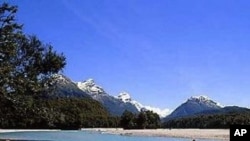Residents in one North Island town warned local water levels so low that they are in danger of running out of supplies altogether
Parts of New Zealand's North Island are experiencing their driest period in 60 years. Residents in one North Island town are being warned that local water levels are so low that they are in danger of running out of supplies altogether. It has come as a shock to New Zealanders, who are used to reliable rainfall. The drought is prompting renewed concerns about climate change and global warming.
The subtropical town of Kaitaia is one of the warmest places in New Zealand. It is also one of the driest, thanks to a drought that began late last year. A lack of rain has forced the popular tourist area, 300 kilometers north of Auckland, to impose water restrictions to conserve dwindling supplies. Other communities in the Northland region are also affected.
Alison Lees of the Far North District Council says the tough conservation measures are urgently needed.
"We do face the prospect of running out of water," said Lees. "We've declared prohibited activities so no hoses and hose attachments, no filling up your spa and your swimming pool and the water levels are critically low and people just have to realize that they must save water."
Residents who violate the new regulations face hefty fines of up to $18,000.
The National Institute of Water and Atmospheric Research says the Northland region is the driest it has been since the 1950s. While many New Zealanders blame climate change, others believe the conditions are simply part of a natural cycle.
Either way, Norm Bryan, who runs a dairy farm north of Kaitaia, says the drought is a real concern...
"We haven't had any real rain for 4.5 months now, I mean 4.5 months that's probably not as bad as what they have in Australia, but for Northland that's pretty bad," said Bryan.
Farmers are being advised how to prepare their land and stock for the dry conditions.
Milk production in the area is down by 40 percent. The dry conditions are also causing problems for the local kiwi population. The normally nocturnal birds are being forced to search for water and food during the day, exposing the iconic flightless creatures to predators.
New Zealand usually enjoys reliable rainfall, but parts of the South Pacific country of more than four million people have experienced droughts in recent years.
Still, most of those dry periods have been far less extensive than those endured by Australia, which remain in the grip of its worst dry spell for 100 years.
New Zealand Facing Water Restrictions as Drought Continues
- By Phil Mercer






